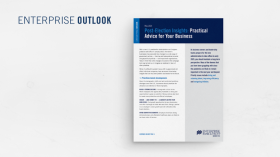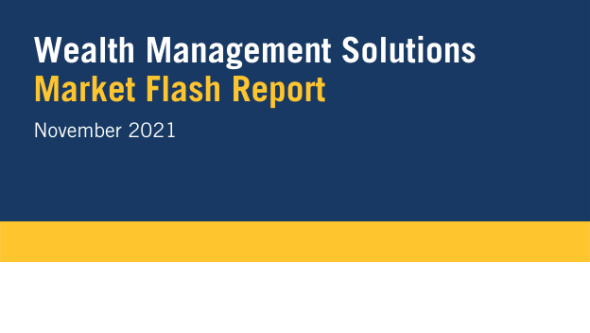
Market Flash Report | November 2021

Economic Highlights
United States
- The November employment report disappointed with only 210,000 new jobs added to the economy. The estimate was 550,000 and the prior two months of readings were revised higher. The unemployment rate fell sharply to 4.2% from 4.6%, even though the labor force participation rate increased for the month to 61.8%, its highest level since March 2020. The broader U6 unemployment rate also declined sharply from 8.3% to 7.8%. Sectors showing the biggest gains in November included professional and business services (90,000), transportation and warehousing (50,000) and construction (31,000). Wages rose 4.8% Y/Y and job growth in leisure and hospitality was weak.
- The latest reading on inflation (from October) showed a 6.2% Y/Y gain in prices that range from energy to food to rent. This marked the fastest reading since August 1991. Stripping out volatile food and energy prices, so-called core CPI was up 0.6% against the estimate of 0.4%. Annual core inflation ran at a 4.6% pace, compared with the 4% expectation and the highest since August 1991. Energy prices overall rose 4.8% in October and are up 30% over the past year. Used vehicle prices again were a big contributor, rising 2.5% on the month and 26.4% for the year. New vehicle prices were up 1.4% and 9.8%, respectively. Shelter costs, which make up one-third of the CPI computation, increased 0.5% for the month and are now up 3.5% Y/Y.
- All eyes are on the Fed and their future monetary policy moves. They have already announced tapering of their monthly bond purchases, but Chairman Powell indicated his willingness to speed up the pace of the taper to counter more sustained inflation. The current pace set by the Fed should have bond purchases wrapped up around the May-June time period in 2022. Any increase in the rate will result in an earlier timeline and it is still important to note that they will be providing some support along the way. As of December 3rd, there is a 68% probability of 2 rate hikes in 2022. We believe the biggest risk to equity markets and the U.S. economy is a more hawkish Fed that is forced to be more aggressive to counter inflation.
Non-U.S. Developed
- The eurozone economy grew 2.2% during the third quarter of 2021 or 3.7% on an annualized basis. Q3 was consistent with the 2.1% GDP reading during Q2. Quarterly growth in July-September was highest in Austria at 3.3%, France at 3.0% and Portugal with 2.9% growth. The eurozone composite PMI increased in November, although there was a lot of dispersion between core and peripheral countries. The composite reading of 55.4 was ahead of the 54.2 October figure, but both Germany and France reported weaker growth readings compared to Ireland, Spain and Italy. Service sector data was stronger than manufacturing which posted its second softest reading since the recovery began last summer.
- Japan's economy contracted much faster than expected in the third quarter as global supply disruptions hit exports and business spending while new COVID-19 cases soured the consumer mood, undermining efforts to stoke a virtuous growth cycle. Japan’s economy shrank 3% on an annualized basis during Q3, well below the estimate of -0.8% and Q2’s upwardly revised 1.5% gain. Consumption fell 1.1%, capital expenditures declined 3.8%, and exports dropped 2.1%. While Prime Minister Fumio Kishida announced plans to compile a large-scale economic stimulus package that will range in the several tens of trillion yen, most economists remain skeptical about whether it will have an impact on economic growth and inflation.
Emerging Markets
- Based on recent economic data, China’s economy appears to slowing further. The country released its manufacturing and service sector PMIs and each showed a weakening of activity. The Caixin Manufacturing PMI fell to 49.9 in November 2021 from
- 50.6 in the prior month. The index plunged into contractionary territory for the second time since April 2020, amid frequent COVID-19 outbreaks and weak demand. New orders fell slightly following two months of expansion and both export sales and employment shrank for the 4th month in a row. The official services PMI was flat in November at a reading of 52.3. While the reading was flat M/M, underlying components such as employment and new orders continued to soften. Similar to the official service sector PMI, the smaller company focused Caixin Services PMI declined to 52.1 in November from 53.8 in October. This marked the weakest growth in three months, consistent with the readings on business activity and new orders that hit their lowest levels in three months.
- Retail sales in China showed a surprise jump in October to a three-month high. Retail sales rose 4.9% Y/Y in October led by strong gains in cosmetics, personal care, home appliances and oil products. YTD, retail sales have surged 14.9% versus the same period in 2020.
- India's economy expanded by 8.4% year-on-year in Q3 2021, following a record 20.1% growth in the previous three-month period. The reading marked a fourth straight quarter of expansion, as coronavirus-related disruptions continued to ease and as economic activity rebounded helped by a faster pace of vaccinations and a drop in cases. The Reserve Bank of India has forecast annual growth of 9.5% in the current fiscal year.
- The Brazilian economy advanced by 4% year-on-year in the third quarter of 2021, slowing from a revised record 12.3% expansion during Q2.
- South Korea’s economy expanded 4% Y/Y during Q3, down from 6% growth in Q2 which marked the highest pace in 10 years.
- Finally, Taiwan’s GDP grew 3.7% during Q3, down from 7.8% growth in the previous quarter.
Market Performance

Fixed Income
- Treasury and sovereign bond yields moved lower last month, boosting core fixed income and munis.
- HY sold off with other risk assets, but floating rate loans benefited from their position as a hedge against higher rates.
- Bonds outside the U.S. were hit hard by USD strength.
U.S. Equities
- U.S. equities were mostly weak in November outside of growth/tech stocks.
- Small caps were particularly weak
- relative to large caps.
- LCG beat LCV, but SCG was weak versus SCV.
Non-U.S. Equities
- Non-U.S. equities underperformed U.S. equities last month with substantial weakness in value stocks, Europe and EMs.
- Growth beat value outside the U.S. and large caps outperformed small caps.
- EM equities fell over 4% led by declines in Eastern Europe and China.
- USD strength detracted 214 bps from EAFE returns, but added 86 bps to EM returns.
Sector Performance – S&P 500 (as of 11/30/21)

Source: Russell, Morningstar Direct

Sector Performance – MSCI EAFE (as of 11/30/21)

Sector Performance – MSCI EM (as of 11/30/21)


